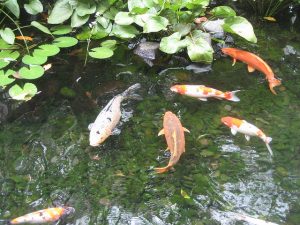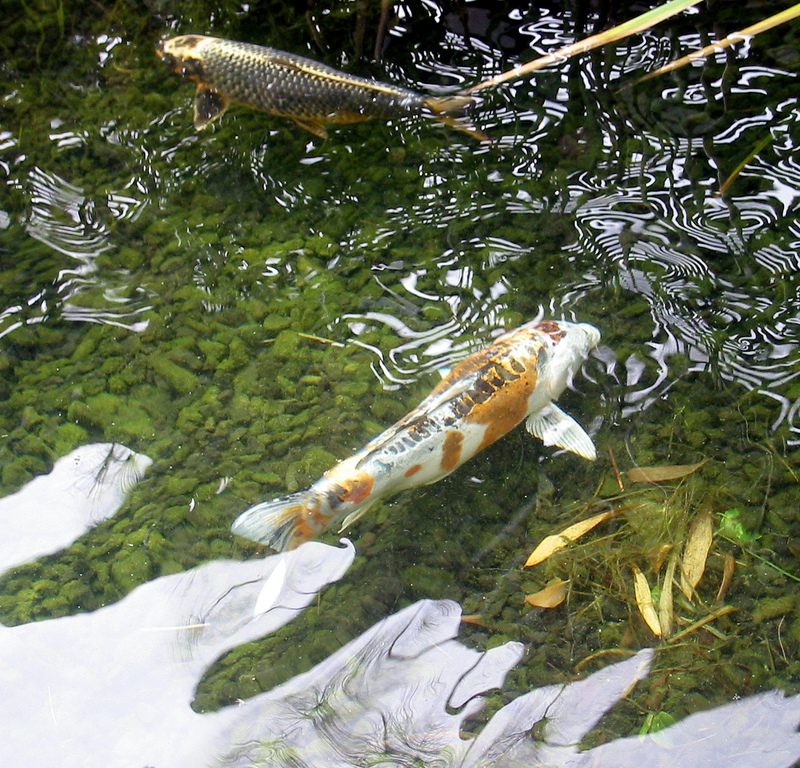So what is the deal with gravel koi ponds?
Hop on any forum chat or social media post thread and you will get quite a bit of vitriol surrounding the use of rock on the bottom of koi ponds. More often than not, those that have had experience with it (specifically a negative one) will ardently dissuade anyone that is asking “should I?” to should steer as far clear of it as possible.
However, there are some dissenting voices who will sing gravel’s praises from the highest rooftops, both in terms of how easy it is to keep clean and how little maintenance it takes to do so.
For example, if it is a water garden—without koi and the incredible amount of waste that they can create—then a gravel base can be helpful in the filtering of biological and plant waste as well as act like an anchor in which aquatic plants can grow.
It is probably important to distinguish what is meant by “gravel.” There are numerous types of rock available for use in koi ponds, but pea gravel is ordinarily the most used and recommended. Limestone gravel is another common choice, as the basic properties in the Calcium Carbonate can help to regulate the pond’s pH. The limestone will dissolve over time, however. Also, any rock choice that is rough or jagged can cause problems for both the pond liner and the koi fish.
What is Pea Gravel?
As the name suggests, it is gravel that resembles peas both in size and shape. This type of small rock is rounded and is often seen in finishing work on landscaping projects. Because it is rounded, it is more commonly used on pathways.
Pea Gravel comes in different rough sizes. Ponds that use it usually opt for the ⅜” to ¾” in size. The tighter the pack, the better the filtration.
Undergravel Filters
Some koi keepers will build an under-gravel “filtration” system that essentially sucks water through the gravel to keep the waste and finer debris at acceptable levels so that the aerobic bacteria can keep up with the demand. It also needs to be agitated (stirred up) periodically to “encourage” sediment to make its way into the filter.
It is an older (some claim outmoded) system of filtering waste and particulate out of a pond—especially considering the biological filtration that is now available. But it does have those who defend the use of gravel bottoms on koi ponds.
For those that are looking for a no-maintenance filtration setup, this is not for you. Even those that love their gravel bottoms admit that maintenance is essential. It is not a drop-and-forget type of material.
This Pond Trade Magazine article extols the virtues of an under-gravel suction filter. The system has ⅜” holes drilled into a grid of 3” PVC pipes at 6” intervals, and are buried underneath the gravel.
The article maintains that the numerous ⅜” holes coupled with the 6” spacing between the pipes across the entirety of the pond’s bottom create a big enough grid that a mass clog (and therefore the need to perform a mass line clean) is unlikely. The author’s assertion is that his system requires very little maintenance.
Here is a video of a DIY under gravel set up for a small tank. It is a little different than that used in a larger koi pond, but the principle is similar
But there are some experienced koi keepers who claim that a similar setup clogged in less than 6 months, requiring an entire pond clean as well as a removal of all the gravel.
Another champion for gravel-bottomed ponds is Mike Gannon of Full Service Aquatics. His article Pond Gravel For Your Pond? outlines his love for gravel-bottom ponds, but also points out that maintenance and cleaning (even if it is annually) is probably why his continues to be a success.
Pros for Gravel Koi Ponds
Aesthetics
Quite simply, rock in a koi pond looks nice. Some enthusiasts prefer it to a black liner pond bottom. In aquarium or tank setups with fish that don’t generate as much waste, it can be an attractive addition to the bottom.
Filtration
Those that use gravel successfully point to both the mechanical and biological filtration benefits that rock brings.
Mechanical
Used effectively, it can function as a mechanical filter to remove particulate and sediment from the water column.
Biological
Pea gravel can also provide a breeding ground for the beneficial bacteria that help to break down nitrogenous waste and help to keep the water parameters within acceptable levels to sustain both plant and fish life.
Cleaning
Those gravelistas that find it to be a great way of maintaining water quality often point to how this old school means of filtering their ponds can be a breeze in koi ponds. Some say it takes them an hour once a year. Others say minutes a week.
Cons for Gravel Koi Ponds
The Sewer Effect
Gravel bottom ponds can go wrong. And when they do, they really do! Gravel can help to cultivate beneficial bacteria. But without the requisite amount of oxygen, it can turn anaerobic—and this is where it becomes harmful to your koi.
Also, when waste material and debris build up quicker than filters and/or bacteria are capable of dealing with, it can become a smelly (and harmful) mess to clean up turning your koi pond into a koi pong.
There are more than a few koi keepers and pond builders who will have to shovel through what is essentially a sewer comprised of small round rocks, and the stench is incredible.
Water Clarity
One of the methods of cleaning gravel on the bottom of a koi pond is to agitate it or stir it up periodically. This then releases all the sediment into the water where the suspended sediment can be picked up by other filters. This will cloud your water for a few days depending on the size of your pond and type/size of your filtration.
Channeling
Over time, the water flow can create channels in the pea gravel, creating pockets of anaerobic bacteria which in turn release harmful gases (hydrogen sulfide in particular, which is lethal to humans and fish).
Cleaning
If the gravel does become a safe haven for all of the bugs, critters, and bacteria that can turn your pond into a cesspool, it can be an arduous task to clean your gravel bottom. From draining the pool to then rinsing it or even removing it permanently, it can be a time-consuming and foul-smelling job.
Even routine vacuuming will not get it clean. Vacuuming will only move the larger debris.
Stocking Density
Some people like a lot of koi, and will on occasion overstock their ponds. This means more organic matter in the gravel. Any biological filtration system that is overloaded will struggle, but gravel (and rock in general) is harder to clean and will harbor the waste, creating a potentially lethal situation for the koi.
Damage  to Koi
to Koi
As natural foragers, koi will suck up the gravel looking for food. If your gravel is not smooth, sharp pieces of stone can inadvertently be sucked up, damaging the gills and mouths of the koi.
Similarly, sharp pieces of gravel can cause damage to the pond liner.
As in many aspects of pond and koi keeping, experience is usually the determining factor in whether or not a koi keeper demonizes or lauds pea gravel to line a pond bottom. On balance, however, it appears that the “nays” far outweigh the “yays.”
One major caution from those “nays” that have used rock and gravel in their ponds or bog and not had a pleasant experience (and there are many!), is to look at from whom the pro-gravel advice or endorsement is coming. It may be a case of pushing products and/or services.


I found this article interesting. I appreciated the candid advice. I personally feel that unless you have pvc tubing placed beneathe the gravel and that you have an all concrete pond the gravel is pretty but not worth the problems. This comes from thirty years of experience for what thats worth. Thanks I enjoyed the article.
James, thanks for your input. I think it really does come down to personal preference. It works well for some, while others would never recommend it.
I have 4 Koi ponds the largest which is 60 thousand gallons. In all my ponds I have UGF systems that I have been using for the past 10-12 years. I have never changed the water. I use 2-3 inch river rock which has smooth edges. Also in each pond there are at least 30-50 turtles which produce a lot of waste and they never attack the fish.
I have tried every filtration system on the market and they are not as efficient as the UGF system. The ph in every pond is perfect.
I have a submersible pump that is rated for5,000 gph. That leads to a25foot stream. My question is how would i connect the UGF to my existing pump?
Your best bet is to contact a pond construction professional in your area to answer your questions.
building a koi pond and was wanting to know the best gravel/ pond rock to put on my liners
Hello Michael,
We suggest contacting an Aquascape Pond Builder or Certified Aquascape Contractor in their area – https://www.aquascapeinc.com/find-aquascape-certified-contractors
They are very knowledgable with pond builds and maintenance.
Thank you.
Thank you for your information about pea gravel and rocks. I just built a 3 ft deep x 3 ft across x 14 ft long. One side I did go up to about 18″ just as a shelf. I do feed the fish near the shallow side. I notice that I did put river rocks about half of it. I want To see if I would like it or not. Now the rocks are all over the hole bottom. And they are not to small of rocks. Lol
Thank you,
Michael
I am planning to install indoor fiberglass koi pond 19 feet by 7.6feet by 30 inches deep with waterfalls . Contractor planning to create waterfall with fake rocks and I am not sure fake rock would be harmful to koi fish . And without lining with rocks for bottom of pond is easier to filter fish wastes right?
[…] Limestone gravel is another common choice, as the basic properties in the Calcium Carbonate can help to regulate the pond's pH. The limestone will dissolve over time, however. Also, any rock choice that is rough or jagged can cause problems for both the pond liner and the koi fish. via […]
[…] Pea gravel can also provide a breeding ground for the beneficial bacteria that help to break down nitrogenous waste and help to keep the water parameters within acceptable levels to sustain both plant and fish life. via […]
[…] Limestone gravel is another common choice, as the basic properties in the Calcium Carbonate can help to regulate the pond's pH. The limestone will dissolve over time, however. Also, any rock choice that is rough or jagged can cause problems for both the pond liner and the koi fish. via […]